Tags
bell-heather, coastguard cottages, coastline, Dunwich Heath, dwarf gorse, erosion, gorse, heather, heathland, ling, marram, National Trust, sandlings, Sea Kale, shingle beach, Suffolk
Richard, Elinor and I took a trip to Dunwich Heath at the end of August last year. We wanted to go somewhere different to our usual places but didn’t want to make a long journey.
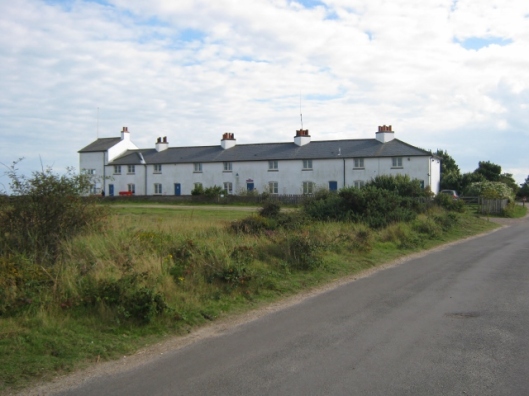
The old coastguard cottages. The National Trust tearoom is situated in the end cottage. The other cottages are rented out as holiday homes.
The County of Suffolk has six topographical regions each with its own distinct landscape features. I live in High Suffolk with its boulder-clay soil but just a couple of miles to the East of us the soil changes and becomes sand and gravel. This gravelly area is called The Sandlings and Dunwich Heath (part of the Sandlings) is right on the coast. To quote the National Trust description of the area –
‘Dunwich Heath is where the Sandlings meets the sea. It is 87 hectares (215 acres) of heather, gorse, grassland, woodland and crumbling sandy cliffs, as well as a mile of shifting sand and shingle beach. The Sandlings landscape was created by early farmers thousands of years ago. The sandy, free-draining soils became dominated by heather as farmers cleared the trees and introduced sheep to graze the land.
Within the Sandlings, only at Dunwich does the heathland extend to the cliff top – a rare example of coastal lowland heath.’
Late summer and early autumn is the best time to visit heathland as that is the time the heather is in flower.
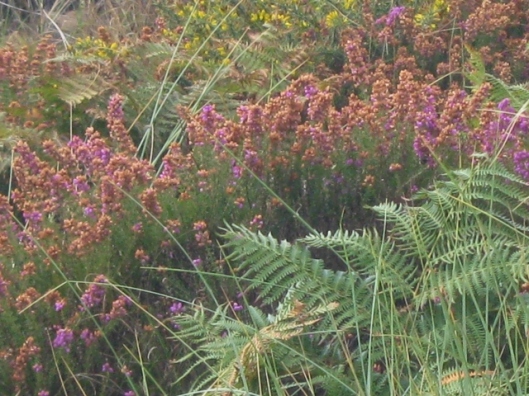
Heather, gorse and bracken by the side of the path. This heather is going to seed; I love the orange colour of the seed capsules.

We found Sea Kale (Crambe maritima) as usual, with Marram grass (Ammophila arenaria) and Gorse behind it
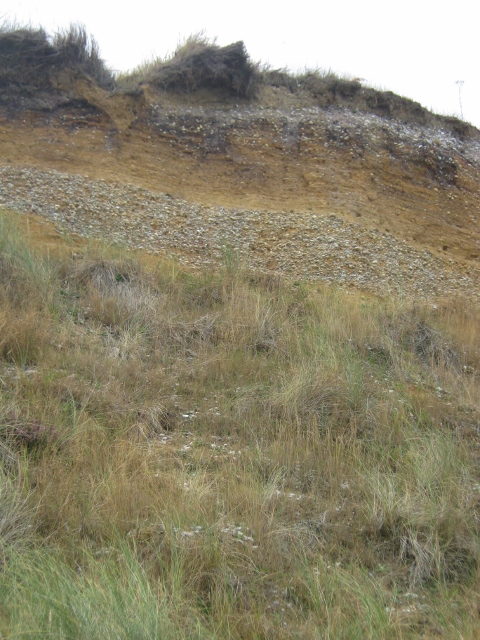
You can see here what the cliffs are made of – sand and gravel in layers. It is no wonder they are crumbling away.
The sands are known as ‘crags’. The southern sandling crags are the oldest – a shelly ‘Coralline Crag’ which was deposited in warm tropical conditions about 3.5 million years ago forms an island and is surrounded by a sea of ‘Red Crag’ which is also full of fossilised shells. The northern crag known as ‘Norwich Crag’ is younger and is less than 2 million years old. Dunwich Heath is part of the ‘Norwich Crag’.
I have found three Belemnite fossils in my garden. Perhaps some gravel containing these fossils was brought to the area when the house was built or perhaps the land where we live is the border between the clay soil and the sandy soil.

The little holes are probably Sand Martin (Riparia riparia) nestholes. The pipe sticking out at the top left of the picture is probably a land drain.
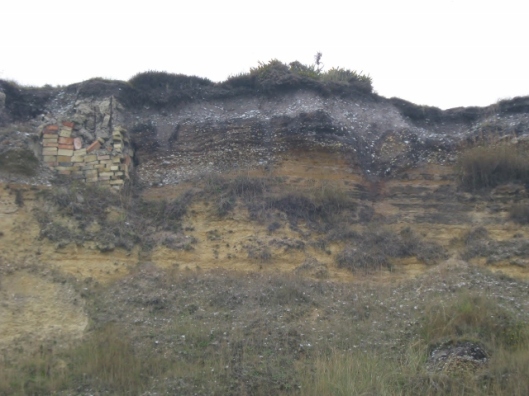
Dunwich has disappeared into the sea at a rate of about 400 metres in 400 years. Houses and other buildings are still lost regularly. I don’t know what the structure at the top left of the picture is, or was!
Richard and I left Elinor on the beach and went for a walk.

There were plenty of flowers and grasses to see. Further away across the water meadows and marshes are the two nuclear energy plants at Sizewell.
I heard and then saw a Dartford Warbler (Sylvia undata) on the top of a Gorse bush, but he was too far away to photograph.
This next photograph really makes me laugh!
‘Oh wad some power the giftie gie us / To see oursel’s as others see us! / It wad frae monie a blunder free us, / And foolish notion.’ Robert Burns
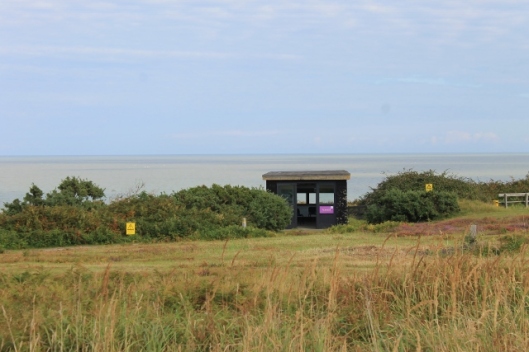
A sea-watch shelter. Looking at the water can be interesting and calming in itself but often ships, boats and other craft can be seen as well as sea-birds and mammals such as dolphins and seals.
We ended our visit with a cake each and a drink of choice at the tea-room.
Thank-you for visiting!

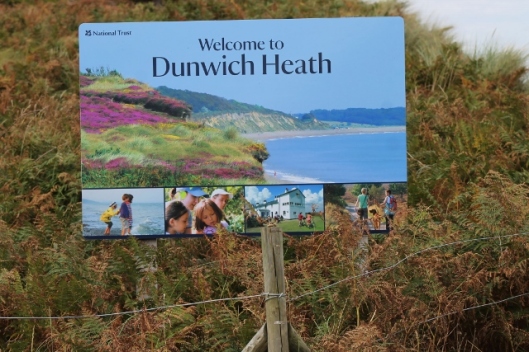
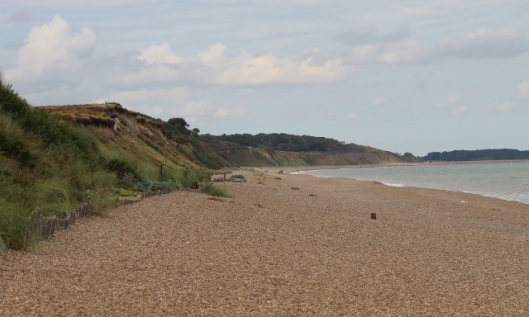
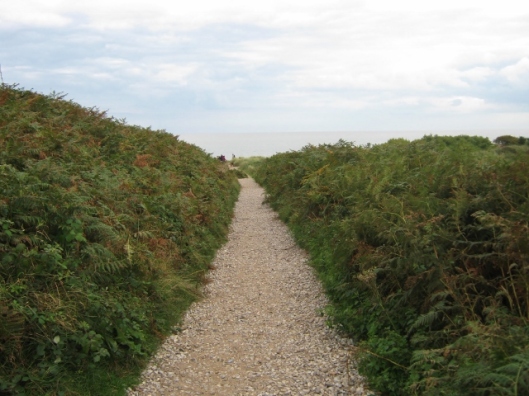


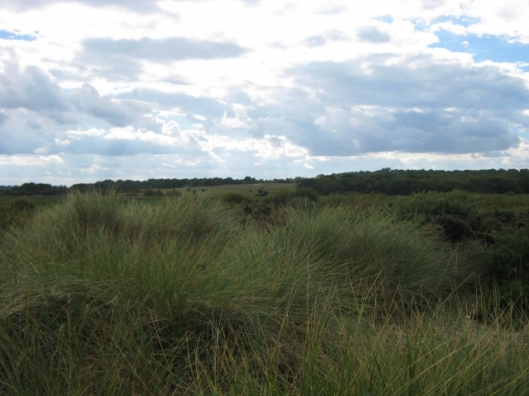





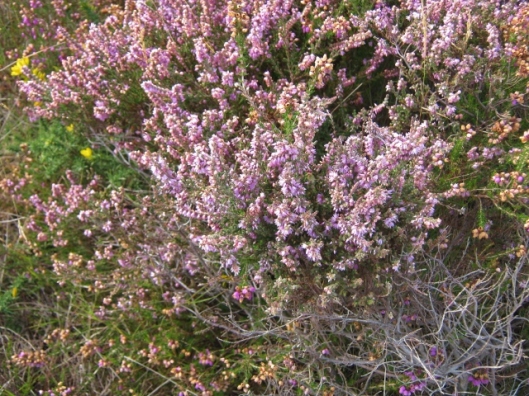
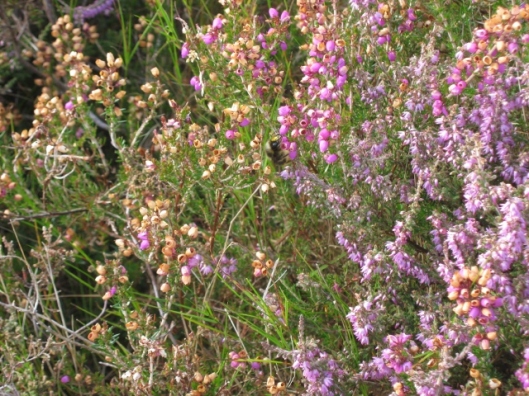
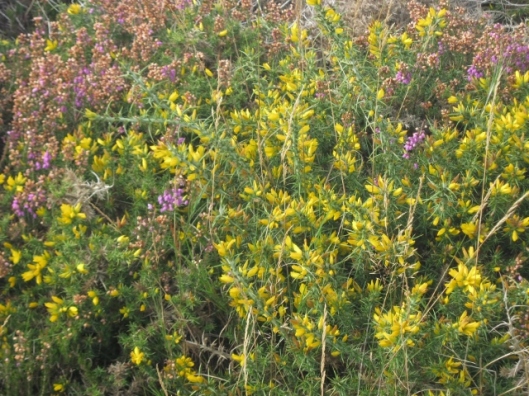


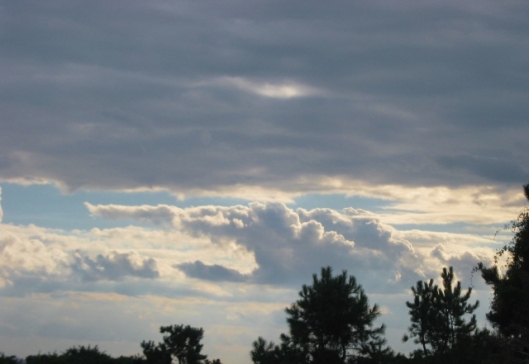
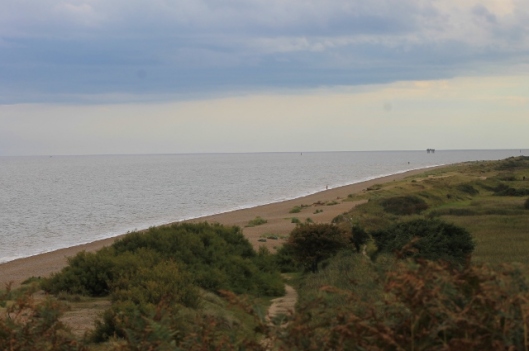

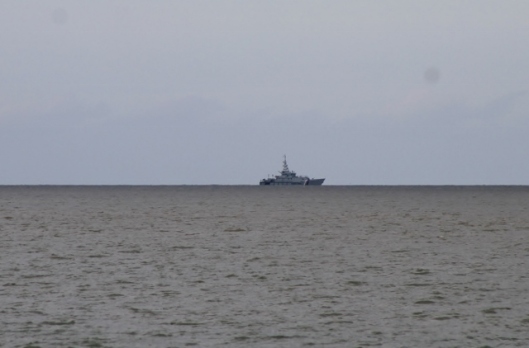
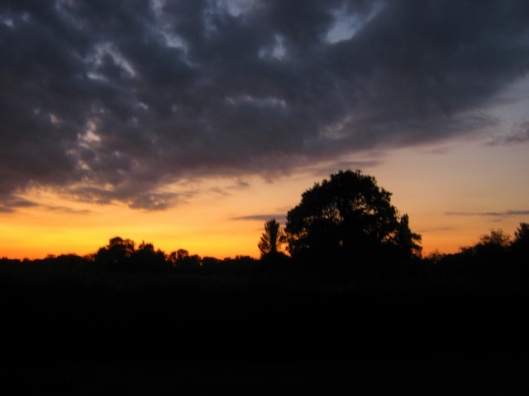
Lovely post Clare, I laughed too at Elinor’s expression, I can see my own children doing that to me. We visited Dunwich Heath last year but in late July and had a wonderful walk through the heath. I love this stretch of the coast, you are lucky to live so close.
LikeLiked by 1 person
Thank-you Julie. Children, especially teenagers, are such treasures, aren’t they? 🙂 We are very lucky indeed to live such a short journey away from Dunwich.
LikeLiked by 1 person
I love when you take a trip Clare because then I get to go along as well. 🙂 Your photographs are so beautiful. How I would love to walk along that beach path. As for Elinor’s expression…priceless!
LikeLiked by 1 person
Thank-you Jill! I am so pleased you enjoyed your trip. I am sure that if I had turned towards her, Elinor’s face would have been looking quite different!
LikeLiked by 1 person
I love it!
LikeLiked by 1 person
Thank-you!
LikeLiked by 1 person
Dunwich Heath looks like a lovely place to visit! And a lovely sunset to end the day. 🙂
LikeLiked by 1 person
Thank-you Lavinia! It is a wonderful place to go with so much to see.
LikeLike
My daughter looks at me like that too! (not all the time thankfully). I love the expanse of heather and the link with the past with the plaque. Seeing that Armada coming must have been scary.
Always great to visit a tea room at the end of a day out (or indeed in the middle of one!)
LikeLiked by 1 person
Thank-you Rachel! I’m glad I’m not the only mother with a daughter who pulls those kind of faces! Tea rooms are such a comfort aren’t they, especially on wet days and/or when the place you’ve visited hasn’t been all that great! The Channel isn’t quite as narrow as it is off the Kent coast but large fleets of ships must have been easy to see – quite a sight during war years. The unsuccessful Battle of Sole Bay was fought just off the coast here at the beginning of the 19th century.
LikeLike
I wish we could travel back in time just to glimpse what it would have been like.
LikeLiked by 1 person
Oh so do I! I wouldn’t want to stay but just to get a bit of an idea of how things were. I think we might have been surprised at how dirty and smelly a lot of places were!
LikeLike
Absolutely – just stay and take a look then back to modern day comforts.
LikeLike
How lovely. Perhaps this is somewhat like the country that Jane Eyre traveled. She is one of my favorite women heroines, so strong and so ethical.
LikeLiked by 1 person
Yes the heathland would have looked a little like this in places. The moorland she walked across was much bleaker and at a much higher altitude with lots of stone boulders to clamber over too. I love Jane Eyre as well. I think the Bronte sisters would have been like Jane Eyre – used to hardship and hard work and, as you say strong and ethical. I have visited Haworth Rectory where the Brontes grew up. It looks quite cosy now but with a bit of imagination one can see how isolated and deprived their lives must have been.
LikeLike
What a great post!! I miss the sea and your photos made smell the salty air and hear the rolling waves. The heather is gorgeous and Elinor’s expression priceless! Lovely, lovely, lovely!!! xo Johanna
LikeLiked by 1 person
Thank-you Johanna! Living near the sea we often forget how lucky we are and don’t think of visiting the beach for months at a time! When Elinor was a tiny girl we often took her to the beach to keep her quiet and happy. She was (and still is) quite happy to be there at any time of the year and I remember standing about for ages freezing cold in January and February while she dug in the sand with her spade.
LikeLiked by 2 people
We are not far from the sea either but rarely go there. And, yet, we love the sea and beaches.
LikeLiked by 1 person
Isn’t it strange! So many people would give anything to live near the sea and would take advantage of it too. When I lived half-an-hour’s train journey from central London I hardly ever went there and it’s only now I wish I’d visited all the galleries and museums.
LikeLiked by 1 person
Oh yes, I know that scenario too. I had a year in Oxford; went to London once, during that year, I think. Mind you, one could spend several years in Oxford and never see and do all that needs to be seen and done.
LikeLiked by 1 person
I have never been! I would love to go – my eldest daughter and husband have been and sing its praises.
LikeLiked by 1 person
That would be a great place to visit but I’m not sure I’d want to live there with the land crumbling out from under the houses like it does. it’s always nice to be at the seashore though.
The heather is really beautiful!
LikeLiked by 1 person
Thank-you Allen. Yes, we feel the same. I wouldn’t want to live within a mile of the coast here because of the erosion problems. No insurance company is interested in insuring property that might fall down the cliff in a few years.
The heather is so lovely at that time of year. The different shades of pink heather flowers, the orange of the seed capsules and the bright yellow of the gorse is a real surprise when you see the heath for the first time!
LikeLiked by 1 person
An excellent place to visit. I like the idea of a sea watch hide.
LikeLiked by 1 person
It’s very useful and keeps out the windy blast!
LikeLike
Wonderful post! I love Dunwich Heath, and it was lovely to visit with you, very interesting about the geology too.
LikeLiked by 1 person
Thank-you Chiara. I find geology fascinating. It certainly explains why this coast is crumbling away so quickly.
LikeLiked by 1 person
Lovely pictures! The flowers are so beautiful. I very much love the sea, so thank you for the virtual tour, Clare! It was very pleasant. Have a great day!
LikeLiked by 1 person
Thank-you Lucy! I am so pleased you enjoyed the visit. Best wishes, Clare xx
LikeLiked by 1 person
A great delivery as per sual dear Clare… Lovely surroundings, perfect for a walk… As I once told you, you are lucky to live there!… It is truly beautiful..
Best wishes and happy weekend ahead!. Aquileana 😀
LikeLiked by 1 person
Thank-you dear Aquileana. I hope you have a wonderful weekend too! Clare 😀
LikeLike
The photos of the heath in bloom were fabulous! I found the history and geology that you provided to be almost as interesting, but it’s hard to overlook so many beautiful flowers in bloom at the same time.
LikeLiked by 1 person
Thank-you Jerry. The heath was breath-takingly beautiful.
LikeLiked by 1 person
Clare you are a treat…I loved taking this trip with you. Elinor’s expression is priceless. Hugs and ❤ always x
LikeLiked by 1 person
Thank-you Jane! With love and hugs ❤ xx
LikeLiked by 1 person
All such visits require cake.
I love seeing your part of England, which I’ve only ever past through on my way elsewhere. Heather is beautiful. Every time I see it I’m reminded of the North York Moors and feel a moment of nostalgia for home.
LikeLiked by 1 person
Thank-you Kate. I have strong memories of long walks on the N York Moors when I was a girl on a holiday with my parents; my Dad always suggested short cuts which never were and added about an hour to the walk!
LikeLiked by 1 person
When someone says ‘short cut’ I too know to worry.
LikeLiked by 1 person
What a beautiful place. My favourite picture was the little Parasol mushroom, I would have had that for my supper 🙂 It reminded me of a favourite spot that I used to visit to collect Parasols and that was in a patch of Heather. I wonder if there is a connection between the species.
LikeLiked by 1 person
There probably is. This one wasn’t so little it was nearly 2 foot high. I would have liked to see it the next day to see how much bigger it became.
LikeLike
Absolutely beautiful!
LikeLiked by 1 person
Thank-you so much, Chasidy!
LikeLiked by 1 person
I think my family name comes from Suffolk people of the Heather. I’m going to have to check with my Dad, it was either Suffolk or Sussex.
LikeLiked by 1 person
Sussex has lots of heathland too so it could be either!
LikeLike
Oh my, such a panoply of purple. Gorgeous. And very apt words from Burns to go with the photo of you and Elinor.
LikeLiked by 1 person
Thank-you! I thought the words were apt! If I had turned to look at her I’m sure that expression wouldn’t have been there. I would never have known if my husband hadn’t taken the photo and he wasn’t looking at her expression, he tells me!
LikeLiked by 1 person
Pingback: Brancaster Beach | A Suffolk Lane